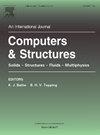在多材料拓扑优化中引入材料特有的应力约束
IF 4.4
2区 工程技术
Q1 COMPUTER SCIENCE, INTERDISCIPLINARY APPLICATIONS
引用次数: 0
摘要
多材料拓扑优化已经成为一种强大的设计工具,可以整合不同的材料特性来提高结构性能。将应力约束应用于多材料结构的一个关键挑战是,每种材料都有不同的应力极限,不能超过。传统方法通常通过对所有材料施加单一应力限制或使用插值函数来解决这一问题,这两种方法都引入了限制和额外的复杂性。相反,我们提出了一种材料特定的应力约束方法,分别对待每种材料。每种材料的应力都是单独计算的,并直接与各自的应力极限进行比较,从而消除了额外的插值函数的需要。此外,不需要松弛技术就可以自然地避免应力奇点现象。为了解决优化问题,采用了一种基于CNN的图像再生方法。开发了一种严格执行质量约束的投影滤波器,同时保证了有效的材料分布。通过三个算例验证了应力约束对最小柔度问题的影响。结果表明,在确保所有材料的应力都保持在各自的极限范围内的同时,应力水平显着降低,以换取顺应性的小幅增加。本文章由计算机程序翻译,如有差异,请以英文原文为准。
Introducing material-specific stress constraints in multi-material topology optimization
Multi-material topology optimization has emerged as a powerful design tool, enabling the integration of different material properties to enhance structural performance. A critical challenge in applying stress constraints to multi-material structures is that each material has a distinct stress limit that must not be exceeded. Conventional approaches typically address this by enforcing a single stress limit for all materials or using interpolation functions, both of which introduce limitations and additional complexities. In contrast, we propose a material-specific stress constraint method that treats each material separately. The stress in each material is computed individually and directly compared to its respective stress limit, eliminating the need for additional interpolation functions. Furthermore, the stress singularity phenomenon is naturally avoided without requiring relaxation techniques. To solve the optimization problem, an image regeneration approach based on CNN is employed. A projection filter is developed that strictly enforces the mass constraint while ensuring a valid material distribution. The method is evaluated through three numerical examples, demonstrating the impact of stress constraints on the minimum compliance problem. The results show a significant reduction in stress levels, in exchange for a small increase in compliance, while ensuring that the stress in all materials remains within their respective limits.
求助全文
通过发布文献求助,成功后即可免费获取论文全文。
去求助
来源期刊

Computers & Structures
工程技术-工程:土木
CiteScore
8.80
自引率
6.40%
发文量
122
审稿时长
33 days
期刊介绍:
Computers & Structures publishes advances in the development and use of computational methods for the solution of problems in engineering and the sciences. The range of appropriate contributions is wide, and includes papers on establishing appropriate mathematical models and their numerical solution in all areas of mechanics. The journal also includes articles that present a substantial review of a field in the topics of the journal.
 求助内容:
求助内容: 应助结果提醒方式:
应助结果提醒方式:


